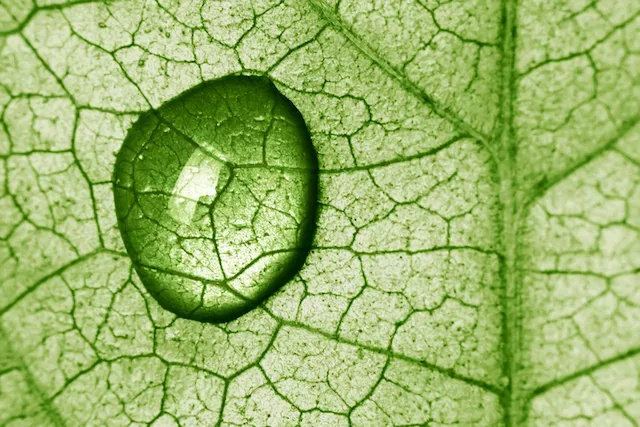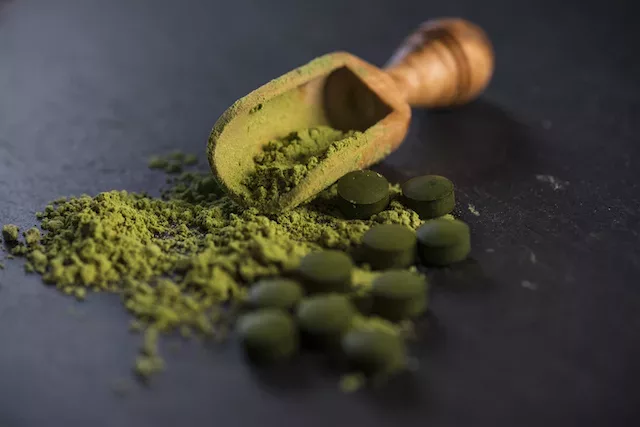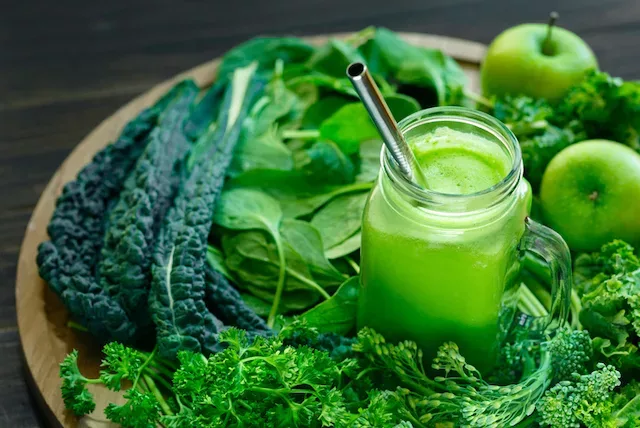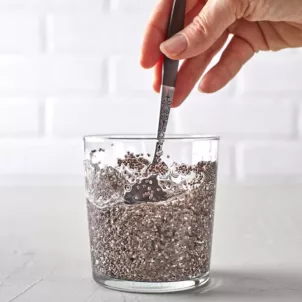Discover the amazing benefits of chlorophyll and how to incorporate it into your daily routine. Our article explores the numerous health benefits of chlorophyll, provides tips on how to take it, and highlights the best sources. Plus, don’t miss our delicious chlorophyll recipe to supercharge your well-being and add a refreshing twist to your meals (hint: it includes celery!).
Chlorophyll is a pigment that is mainly found in green plants and algae. It plays a vital role in converting sunlight to energy, a process known as photosynthesis. Because chlorophyll packs many antioxidants and vitamins, people have turned to chlorophyll water and chlorophyll drops to reap its potential benefits. As such, there’s a ton of interest on the potential chlorophyll benefits for health ranging from detoxification to body odor.
In this article, we’ll cover the benefits one can expect from trying chlorophyll, plus tips on how to take chlorophyll, and a delicious chlorophyll green juice recipe.
The 3 Health Benefits of Chlorophyll
Traditionally, chlorophyll has been used to address odor-related ailments. More recently, chlorophyll has made headlines for its ability to affect more areas of the body.
Here are the top 3 benefits of chlorophyll:
1. Detoxifies
One of the primary benefits of consuming chlorophyll is its potential to support the body’s detoxification process.
Specifically, chlorophyll influences a type of detoxification that happens at the cellular level. This type of detox happens when the liver (the body’s main detox organ) uses specific enzymes to change potentially harmful substances into less absorbable forms so that they can be eliminated from the body.
Interestingly, multiple studies have reported that chlorophyllin, the water-soluble derivative of chlorophyll, is capable of inducing the enzymes responsible for this type of detoxification.
It’s important to keep in mind that your body already has detox systems in place. Ingredients like chlorophyll, are simply giving these systems a helping hand.

2. Protective Antioxidant
Another perk associated with chlorophyll is that it functions as an antioxidant. This means it can help shield against free radicals. Free radicals are harmful molecules that are highly unstable. In excess, free radicals can cause oxidative stress. Unfortunately, oxidative stress leads to cell and tissue damage.
Fortunately, antioxidants can help clear out free radicals by scavenging and neutralizing them. In other words, they help stop free radicals in their tracks. In turn, this helps prevent accumulation in the body.
Using a molecule called porphyrin, chlorophyll is able to provide antioxidant benefits throughout the body.
3. Deodorizes
Historically, chlorophyll is used as a deodorizer. People who struggle with urinary or fecal odor, and even bad breath, turn to chlorophyll for relief.
In terms of urinary and fecal odors, the research is split.
For instance, one study did see a 21% decrease in urinary odor intensity in geriatric patients who took chlorophyllin for two weeks compared to the placebo group. However, a clinical study with a similar design showed no difference in urinary odor improvement between the chlorophyllin and placebo groups.
In addition, much of the evidence supporting its efficacy for reducing bad breath is anecdotal or outdated.
The most recent research dates back to the 1950’s. While the study did suggest that chlorophyll can be beneficial for bad breath, experts have mixed opinions as to whether or not it makes a difference.

Where to Find Chlorophyll
As mentioned, dietary chlorophyll can be found in green plants and algae. Chlorella and spirulina are two examples of algae that get their green pigment from chlorophyll.
Chlorophyll is also present in a variety of dietary sources. Naturally, you’ll see this pigment in green fruits and vegetables.
Some of the most popular dietary sources of chlorophyll include leafy green vegetables like collard greens, kale, lettuce, parsley, and spinach. Green celery also contains a high amount of chlorophyll.
Another way that people boost their daily chlorophyll intake is by consuming wheatgrass. Wheatgrass is made from the baby leaves of the wheat plant. People enjoy taking wheatgrass in drink or supplement form. In addition to delivering chlorophyll, it’s popular for its vast nutritious profile and potential to support the body’s detox processes.
It is worth mentioning that dietary sources of chlorophyll are going to provide “natural chlorophylls”. This type of chlorophyll may be less beneficial than its derivative sodium copper chlorophyllin (a.k.a Cu-chlorophyllin). Sodium copper chlorophyllin, has been shown in the literature to deliver a higher antioxidant activity compared to other natural forms of chlorophyll.
How to Take Chlorophyll
Prioritizing leafy greens and fruits in your everyday diet is going to be the best way to ensure that you are getting chlorophyll regularly. But if you want to maximize the benefits that chlorophyll has to offer, find a quality supplement that delivers sodium copper chlorophyllin.
Sodium copper chlorophyllin supplements are available in a variety of forms including:
- Liquid chlorophyll drops (to make chlorophyll water)
- Capsules
- Powders
- Gummies
Currently, there is no established recommended dose for chlorophyll. However, researchers have studied doses as low as 8 mg to upwards of 100 mg. In any case, you can complement a diet rich in green fruits and veggies with a chlorophyll supplement to support your overall health.

Delicious Chlorophyll Recipe
Taste the goodness of chlorophyll with this refreshing, nutrient-rich juice. This Chlorophyll Green Juice recipe delivers chlorophyll in its natural form with green fruits and veggies. If you want to add more antioxidant potential, simply add in your favorite sodium copper chlorophyllin supplement.
Chlorophyll Green Juice
Makes: 2 to 3 servings of juice
What You’ll Need
- 3 stalks of celery
- 3 tbsp of lemon juice
- 1 cucumber
- 1 green apple
- 1 cup of water
- Handful of spinach
- Handful of kale
- 1 serving of sodium copper chlorophyllin (optional; serving size can vary depending on the supplement that you have on hand)
How to Prepare
- Wash all the veggies and fruits
- Chop the veggies and fruits into small pieces for easy juicing
- Juice all the ingredients together using a blender or juicer (Tip: start with the leafy greens and end with the lemon juice)
- Optional: strain through a fine-mesh to remove any pulp
- Enjoy over ice or refrigerate it for later use
If green juice isn’t your thing, you can find sodium copper chlorophyllin in HUM’s Celery Juice Fiber Gummies.

Conclusion
In summary, chlorophyll is more than just a green pigment. It’s a powerful antioxidant that can help support specific detox pathways throughout the body. Plus, people also seem to benefit from taking chlorophyll to address different body odor concerns. Finally, its wide availability in green fruits, vegetables, and supplements makes it easy way to boost your overall health.








